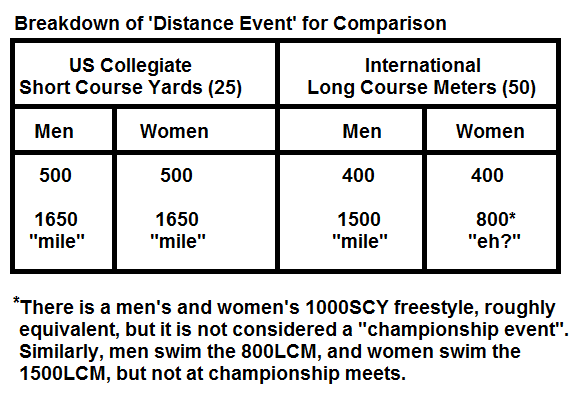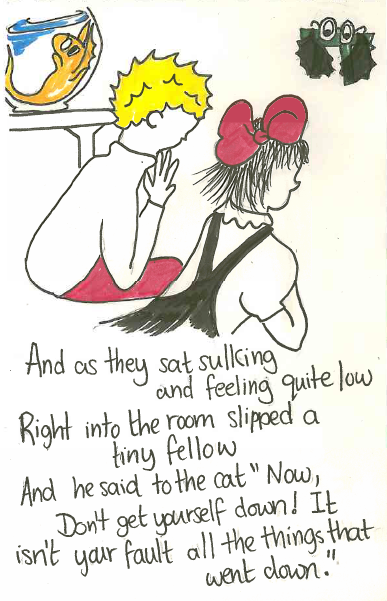There are no locks in Olympic Swimming – anything can happen. But there hasn’t been so dominant a force in the freestyle arguably ever before Katie Ledecky came along. Ledecky made waves at 2012 US Olympic Trials as the 15-year-old prodigy threatening the veterans in crowded events like the 200 and 400 (where she finished 9th and 3rd respectively), and ultimately clinching the top spot in the 800, beating distance pro Kate Ziegler and breaking the USOT record.
Ledecky went on to win the 800 in London, set the American Record, and come just tenths off Rebecca Adlington’s World Record. Everyone said she had the potential to be the next Janet Evans, the US women’s distance swimming legend – suffice it say, that was an understatement!

Star swimmer, 19-year-old Katie Ledecky holds 11 separate world records in various freestyle events in Long and Short Course pools, and is the undisputed queen of freestyle.
Ledecky went on a tear over the last four years, breaking American and World records unrested, in mid-season, toppling giants and separating herself from the rest of swimming world in an amazing way. She is a once in a lifetime talent, with unmatched endurance, but most incredibly of all she has speed. Ledecky is the heavy favorite in the 800m freestyle for both Trials and the Games in Rio, however she could earn herself a spot in the 4×100 freestyle relay, an unprecedented move! She could potentially sweep the 200, 400 and 800!
She has no parallel on the men’s side. Michael Phelps and Ryan Lochte have famed versatility in several strokes, but Ledecky is no slouch there either. She has a top-4 time for the 400 individual medley (once one of Phelps’s and Lochte’s signature events). So I’ll present the other potential qualifiers on the women’s side, but the heavy assumption is that Ledecky is going all the way. For the men, there are still heavy favorites, but it’s a bit more of a contest.
Also, a note – this is where short course yards (SCY) and long course meters (LCM) events diverge drastically. Below is a table of what events are swam in each pool. This will confound comparisons between NCAA collegiate swims and International swims, but I’ll try to lay out the 400, 800, and 1500 events as best I can.

Men
2012
In 2012, NCAA distance events were swept by German swimmer Martin Grodzki. The fact that Grodzki was denied admission to the Olympic Games by the German Federation based on the German’s highly selective qualifying times is a story for another day, but Grodzki would have been fairly competitive on the world stage had he been given the chance.
In the 500 free, Grodzki was followed by Southern Cal’s Christian Quintero Valero, who finished 16th for Venezuela in London, not far behind Germany’s Paul Biedermann. In third, the first American to the wall, was Chad La Tourette of Stanford. Zane Grothe (Auburn), Connor Jaeger (Michigan), Sean Ryan (Michigan), and Michael McBroom (Texas) also all finaled. Georgia’s Andrew Gemmell finished 17th (we’ll get back to him later).
At 2012 Olympic Trials, The 400m free looked similar. The pack was led by veteran Peter Vanderkaay, who was followed closely by Conor Dwyer (the 2011 University of Florida graduate, and 2010 NCAA Champion in the 500 freestyle). Behind the two qualifiers (both 3:47), Michael Klueh, Charlie Houchin and Ryan Feely filled out the top 5, and among the NCAA finalists Jaeger finished 6th, McBroom finished 8th, La Tourette 10th, Ryan 11th and Grothe 14th. The majority of swimmers in the top 16 were in or recently out of college, but the two qualifiers were 28 and 23 respectively.
At the Olympics, Vanderkaay and Dwyer both made the finals and finished 3rd and 5th respectively. China’s Yang Sun won in a 3:40.14, South Korea’s Taehwan Park grabbed 2nd, and Vanderkaay found bronze with a 3:44.69. In this event, no American is in the top 8 all time swimmers (Vanderkaay is 10th, just behind American Larsen Jensen). The world has the edge on the US in this event, but gold is still within reach, with no individual ever going faster than 1:40.
Now looking at the field, Jaeger and Grothe have the top two American times since London, followed by Dwyer and McBroom. Jaeger’s 3:44 is the most competitive time by a good amount, but depending on which of these swimmers step it up the most any one of them could qualify. From the collegiate side, Townley Haas, the freshman from ___ won this year’s NCAAs with a 4:09.00, just tenths off of Peter Vanderkaay’s SCY record. Haas, and Mission Viejo’s True Sweetser are two new faces sitting amid a sea of veterans in the top seeds for Trials. If Haas has what it takes to make a big drop here he could easily nab one of the two spots, but field is distinctly more experienced than in 2012.
As for the mile, Grodzki also won that event at 2012 NCAAs, setting an NCAA record along the way. He was followed there by La Tourette, Jaeger, and Grothe. Andrew Gemmell of Georgia grabbed 5th ahead of Ryan and McBroom. Quintero-Valero finished 9th.
Olympic Trials were a wholly collegiate affair in this event though, as Gemmell upset the field and won with a 14:52, touching out Connor Jaeger. La Tourette missed the games by 5 seconds, and in fourth with a swim almost 20 seconds off his best was Vanderkaay. At the Olympics, Yang Sun took gold with a 14:43, and Jaeger managed to finish 6th with a 14:52. Gemmel just missed the final, snatching 9th.
Jaeger is currently the only American man within 20 seconds of the world record, held by Sun at 14:31. This seems impossibly far off for an American this time around. The NCAA Champion, Chris Swanson, the pride of the Ivy League, is almost 10 seconds off the times of Grodzki and Jaeger in the 1650 – he is currently ranked 45th with his LCM time.
(Fun fact – people think the mile can be boring but in both 2012 and 2016 the race at NCAAs came down to the last 50. Grodzki managed to hold off a surge by Chad La Tourette to win in 14:24.08, with a final split of 24.96 against La Tourette’s 24.06; For Swanson it was the opposite, as he overcame a nearly three-second deficit out-splitting lead Akaram Mahmoud 24.38 to 27.17 to win by .12)!
The real ‘newcomer’ on the field is open water sensation Jordan Wilimovsky – his time of 14:53 in the mile puts him third among active swimmers behind only Jaeger (14:41) and Gemmell (14:52). Wilimovsky was 2015’s “Breakout Swimmer of the Year” and his in-pool times have continued to drop. This Olympic Trials could be the stage where Wilimovsky ignites and puts himself in real contention in Rio.
Wilimovsky also has the dubious honor of being the Olympic 10K open-water favorite, allowing him to navigate the less-than-pristine Brazilian waters. Sean Ryan also grabbed the 10K qualification with strong swims at Worlds in Kazan last fall.
Women
Back in 2012 Katie Ledecky was not the dominant factor she is now, and the race for the 400 free was wide open. NCAA 500 freestyle champion Haley Anderson of Southern Cal, along with Georgia’s Amber McDermott (2nd), UNC’s Stephanie Peacock (3rd), Georgia’s Shannon Vreeland (5th), and Ashley Steenvoorden (6th) all were in the melee for a spot. However, experience and professionals prevailed as Allison Schmitt and Chloe Sutton nabbed the top two spots. The young Ledecky managed 3rd ahead of fellow teenagers Gillian Ryan (then 16), and Becca Mann (14). Veterans Elizabeth Beisel and Kate Zeigler also made the final ahead of the collegiate pack, led by Amber McDermott, who finished 8th. Vreeland, Steenvorden and Anderson finished 9-11 respectively.
At the Olympics Games, Schmitt was edged out by France’s Camille Muffat and found Silver, while Sutton finished 10th. Canadian Brittany MacLean, who would later swim for Georgia, finished 6th as an excited high schooler.
The 2016 scene is an exciting one. Leah Smith of UVA, the NCAA 500 champion, posted a time 4 seconds faster than Anderson’s in 2012. Finishing behind Smith was the Canadian MacLean, followed by Georgia teammate Hali Flickinger. MacLean won the 200 for Georgia, and also claimed silver in the mile.
Looking at the OT qualifiers, Smith has the edge over Cierra Runge (4:03 vs 4:04), who both have faster times than the Silver-medalist Schmitt, though she posted a 4:01 back in London. Becca Mann, still among the youngest in the group 4-years later, is in the mix with veterans like Beisel and Vrooman. Flickinger and Peacock both boast 4:07s to stay on the cusp of possible. But this is Katie Ledecky’s race. She has swum 8 of the top 10 times in history, and seems tireless! Whether Smith, Runge, Schmitt or someone else can nab second is up in the air, but Ledecky should have the first spot locked down.
Whoever makes it with Ledecky will be fighting for medal contention. After Ledecky who can push out a blistering 3:58.37, the Netherland’s Sharon von Rouwendaal and Canada’s MacLean pose the biggest threats, both turning in times around 4:03.
Scaling up to the 800m race, we can first turn to the NCAA mile. In 2012, the mile went to Peacock (who broke Janet Evans’s NCAA record, but was 14 seconds of Katie Hoff’s American Record). Georgia’s Wendy Trott was close behind, followed by Anderson, Steenvoorden, and McDermott. At Trials, Ledecky grabbed the top spot followed by Ziegler, keeping Anderson, Sutton, and Mann at bay. That final heat of the 800 was marked by incredible youth. Four of the eight finalists were under 18, and only Ziegler had graduated college! Ledecky went on to win her first and only Olympic Gold Medal, soundly defeating Mireia Belmonte Garcia of Spain, and Britain’s Adlington.
Now, four years later, Ledecky has the 9 fastest swims in history, and among active swimmers, Great Britain’s Jazmin Carlin is the closest, 9 seconds back. Sutton is not entered in this Olympic Trials so Becca Mann is sitting in a comfortable 2nd, ahead of Runge and Smith, but they’re close enough to make a race out of it. But Ledecky is in a league of her own. Her best time of 8:06 is a mere 5 seconds off of the Men’s World Record set by legend Bobby Hackett in 1976, the last American man to hold the record. Her mile time qualified for US Olympic Trials…by 24 seconds. She would be ranked 25th among the men. Ledecky is truly incredible, and it’s hard not to gush as a writer and as a fan.
In short, the men have their work cut out for them against a very competitive world stage, led by Yang Sun of China; but on the women’s side, it’s a race for second behind the dynamo that is Ledecky.








































